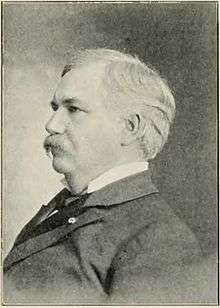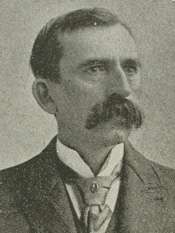United States House of Representatives elections, 1900
| | |||||||||||||||||||||||||||||||||||||||||||
| |||||||||||||||||||||||||||||||||||||||||||
| |||||||||||||||||||||||||||||||||||||||||||
| |||||||||||||||||||||||||||||||||||||||||||
Elections to the United States House of Representatives were held in 1900 for members of the 57th Congress, coinciding with the re-election of President William McKinley.
McKinley's Republican Party gained thirteen seats from the Democratic Party and minor parties, cementing their majority. A reassertion of Republican control in the Mid-Atlantic was key in the gain of new seats. However, with an improved economy, especially in the industrial sector, the election cycle featured no keystone issue, resulting in a general support for the status quo. The fading Populist Party held on to five House seats, while the sole member of the Silver Party changed parties to Democratic.
Election summaries
| 200 | 1 | 5 | 151 |
| Republican | SR | P | Democratic |
| State | Type | Total seats |
Republican | Democratic | Populist | Silver/ Silver Republican | ||||
|---|---|---|---|---|---|---|---|---|---|---|
| Seats | Change | Seats | Change | Seats | Change | Seats | Change | |||
| Alabama | District | 9 | 0 | |
9 | |
0 | |
0 | |
| Arkansas | District | 6 | 0 | |
6 | |
0 | |
0 | |
| California | District | 7 | 7 | |
0 | |
0 | |
0 | |
| Colorado | District | 2 | 0 | |
0 | |
1 | |
1[Note 3] | |
| Connecticut | District | 4 | 4 | |
0 | |
0 | |
0 | |
| Delaware | At-large | 1 | 1 | |
0 | |
0 | |
0 | |
| Florida | District | 2 | 0 | |
2 | |
0 | |
0 | |
| Georgia | District | 11 | 0 | |
11 | |
0 | |
0 | |
| Idaho | At-large | 1 | 0 | |
0 | |
1 | |
0 | |
| Illinois | District | 22 | 11 | |
11 | |
0 | |
0 | |
| Indiana | District | 13 | 9 | |
4 | |
0 | |
0 | |
| Iowa | District | 11 | 11 | |
0 | |
0 | |
0 | |
| Kansas | District +at-large |
8 | 7 | |
1 | |
0 | |
0 | |
| Kentucky | District | 11 | 3 | |
8 | |
0 | |
0 | |
| Louisiana | District | 6 | 0 | |
6 | |
0 | |
0 | |
| Maine[Note 5] | District | 4 | 4 | |
0 | |
0 | |
0 | |
| Maryland | District | 6 | 6 | |
0 | |
0 | |
0 | |
| Massachusetts | District | 13 | 10 | |
3 | |
0 | |
0 | |
| Michigan | District | 12 | 12 | |
0 | |
0 | |
0 | |
| Minnesota | District | 7 | 7 | |
0 | |
0 | |
0 | |
| Mississippi | District | 7 | 0 | |
7 | |
0 | |
0 | |
| Missouri | District | 15 | 3[Note 6] | |
12 | |
0 | |
0 | |
| Montana | At-large | 1 | 0 | |
0 | |
1 | |
0 | |
| Nebraska | District | 6 | 2 | |
2 | |
2 | |
0 | |
| Nevada | At-large | 1 | 0 | |
1 | |
0 | |
0 | |
| New Hampshire | District | 2 | 2 | |
0 | |
0 | |
0 | |
| New Jersey | District | 8 | 6 | |
2 | |
0 | |
0 | |
| New York | District | 34 | 21 | |
13 | |
0 | |
0 | |
| North Carolina | District | 9 | 2 | |
7 | |
0 | |
0 | |
| North Dakota | At-large | 1 | 1 | |
0 | |
0 | |
0 | |
| Ohio | District | 21 | 17 | |
4 | |
0 | |
0 | |
| Oregon[Note 5] | District | 2 | 2 | |
0 | |
0 | |
0 | |
| Pennsylvania | District +2 at-large |
30 | 26 | |
4 | |
0 | |
0 | |
| Rhode Island | District | 2 | 2 | |
0 | |
0 | |
0 | |
| South Carolina | District | 7 | 0 | |
7 | |
0 | |
0 | |
| South Dakota | At-large | 2 | 2 | |
0 | |
0 | |
0 | |
| Tennessee | District | 10 | 2 | |
8 | |
0 | |
0 | |
| Texas | District | 13 | 0 | |
13 | |
0 | |
0 | |
| Utah | At-large | 1 | 1 | |
0 | |
0 | |
0 | |
| Vermont[Note 5] | District | 2 | 2 | |
0 | |
0 | |
0 | |
| Virginia | District | 10 | 0 | |
10 | |
0 | |
0 | |
| Washington | At-large | 2 | 2 | |
0 | |
0 | |
0 | |
| West Virginia | District | 4 | 4 | |
0 | |
0 | |
0 | |
| Wisconsin | District | 10 | 10 | |
0 | |
0 | |
0 | |
| Wyoming | At-large | 1 | 1 | |
0 | |
0 | |
0 | |
| Total | 357 | 200 56.0% |
|
151 42.3% |
|
5 1.4% |
|
1[Note 3] 0.3% |
| |
The previous election of 1898 saw the election of 6 Populists, 2 Silver Republicans, and a Silver Party member.
[[File:57 us house membership.png|thumb|500px|
]] |
[[File:57 us house changes.png|thumb|500px|
]] | |||||||||||||||||||||||||||
Early election dates
In 1900, three states, with 8 seats among them, held elections early:
Complete returns
Party abbreviations
- D: Democratic
- I: Independent
- P: Prohibition
- R: Republican
- Sil: Silver
- Soc: Socialist
California
| District | Incumbent | Party | First elected |
Result | Candidates |
|---|---|---|---|---|---|
| California 1 | John All Barham | Republican | 1894 | Retired Republican hold |
Frank Coombs (R) 55.3% James F. Farraher (D) 42.4% William Morgan (Soc) 1.6% Charles T. Clark (P) 0.8% |
| California 2 | Previous incumbent Marion De Vries (D) resigned August 20, 1900 to accept a judicial position |
Republican gain | Samuel D. Woods[Note 8] (R) 50.4% J. D. Sproul (D) 47.9% W. F. Lockwood (Soc) 0.9% W. H. Barron (P) 0.8% | ||
| California 3 | Victor H. Metcalf | Republican | 1898 | Re-elected | Victor H. Metcalf (R) 58.3% Frank Freeman (D) 38% R. A. Dague (Soc) 2.6% Alvin W. Holt (P) 1.1% |
| California 4 | Julius Kahn | Republican | 1898 | Re-elected | Julius Kahn (R) 55.7% R. Porter Ashe (D) 38.2% Charles C. O'Donnell (I) 3.6% G. B. Benham (Soc) 2.2% Joseph Rowell (P) 0.3% |
| California 5 | Eugene F. Loud | Republican | 1890 | Re-elected | Eugene F. Loud (R) 55.7% J. H. Henry (D) 41.3% C. H. King Sr. (Soc) 2.2% Fred E. Caton (P) 0.8% |
| California 6 | Russell J. Waters | Republican | 1898 | Retired Republican hold |
James McLachlan (R) 52.4% W. D. Crichton (D) 42.4% Noble A. Richardson (Soc) 3.1% A. H. Hensley (P) 2.1% |
| California 7 | James C. Needham | Republican | 1898 | Re-elected | James C. Needham (R) 51.8% William Graves (D) 37.9% H. G. Wilshire (Soc) 7% James Campbell (P) 3.2% |
Florida
| District | Incumbent | Party | First elected |
Result | Candidates |
|---|---|---|---|---|---|
| Florida 1 | Stephen M. Sparkman | Democratic | 1894 | Re-elected | Stephen M. Sparkman (D) 87.0% G. Brown Patterson (R) 13.0% |
| Florida 2 | Robert Wyche Davis | Democratic | 1896 | Re-elected | Robert Wyche Davis (D) 80.0% John M. Cheney (R) 20.0% |
Nevada
| District | Incumbent | Party | First elected |
Result | Candidates |
|---|---|---|---|---|---|
| Nevada at-large | Francis G. Newlands | Democratic | 1892 | Re-elected as Democratic |
Francis G. Newlands (D/Sil) 58.8% E. S. Farrington (R) 41.2% |
South Carolina
| District | Incumbent | Party | First elected |
Result | Candidates |
|---|---|---|---|---|---|
| South Carolina 1 | William Elliott | Democratic | 1886 1896 |
Re-elected | William Elliott (D) 72.7% W. W. Beckett (R) 27.3% |
| South Carolina 2 | W. Jasper Talbert | Democratic | 1892 | Re-elected | W. Jasper Talbert (D) 97.7% J. B. Odom (R) 2.3% |
| South Carolina 3 | Asbury Latimer | Democratic | 1892 | Re-elected | Asbury Latimer (D) 97.5% Anson C. Merrick (R) 2.5% |
| South Carolina 4 | Stanyarne Wilson | Democratic | 1894 | Lost primary Democratic hold |
Joseph T. Johnson (D) 97.0% S. T. Poinier (R) 3.0% |
| South Carolina 5 | David E. Finley | Democratic | 1898 | Re-elected | David E. Finley (D) 97.3% John F. Jones (R) 2.7% |
| South Carolina 6 | James Norton | Democratic | 1897 (special) | Lost primary Democratic hold |
Robert B. Scarborough (D) 94.3% R. A. Stuart (R) 5.7% |
| South Carolina 7 | J. William Stokes | Democratic | 1894 | Re-elected | J. William Stokes (D) 93.2% Alexander D. Dantzler (R) 6.8% |
J. William Stokes (D) of the 7th district died in office on July 6, 1901 and was replaced in a special election by Asbury F. Lever (D)
See also
Notes
- ↑ Three states held earlier elections between June 4 and September 10.
- ↑ Included 2 Silver Republicans.
- 1 2 3 Includes 1 member of the Silver Republican faction, John F. Shafroth, of CO-01.
- ↑ Previous election had 1 member from the Silver Republican Party faction.
- 1 2 3 Elections held early.
- ↑ Elections to MO-12 were contested multiple times, and the seat was considered vacant for much of the 57th Congress – Republican George C. Wagoner was finally seated just before the end of the 57th Congress. See Dubin, p. 333 and 337–338.
- ↑ Previous election had 1 member from the Silver Party.
- ↑ Also won special election to 56th Congress.
References
Bibliography
- Dubin, Michael J. (March 1, 1998). United States Congressional Elections, 1788-1997: The Official Results of the Elections of the 1st Through 105th Congresses. McFarland and Company. ISBN 978-0786402830.
- Martis, Kenneth C. (January 1, 1989). The Historical Atlas of Political Parties in the United States Congress, 1789-1989. Macmillan Publishing Company. ISBN 978-0029201701.
- Moore, John L., ed. (1994). Congressional Quarterly's Guide to U.S. Elections (Third ed.). Congressional Quarterly Inc. ISBN 978-0871879967.
- "Party Divisions of the House of Representatives* 1789–Present". Office of the Historian, United States House of Representatives. Retrieved January 21, 2015.
External links
- Office of the Historian (Office of Art & Archives, Office of the Clerk, U.S. House of Representatives)


